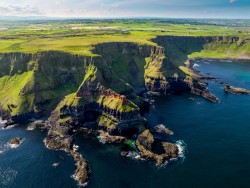
A UNESCO World Heritage Site dating to the Ottoman empire, the reconstructed Old Bridge and Old City of Mostar is a symbol of reconciliation and coexistence of the diversity in Bosnia and Herzegovina.

Built on more than 100 small islands in a lagoon in the Adriatic Sea, Venice is best explored by gondola.

The Guaita fortress is the oldest of the three towers constructed on Monte Titano that overlooks the capital of San Marino.

In the southern Andalusia region, Granada contains grand examples of medieval architecture from the Moorish occupation, especially the Alhambra fortress overlooking the entire city.

Drinking in history, the Irish capital is home to a medieval castle, cobblestone streets, and the 12th-century Saint Patrick’s Cathedral.

Paris is instantly recognizable with monument-lined boulevards, classic sidwalk cafés, and world renowned museums.

One of the world’s top art hubs, Florence is considered the birthplace of the Renaissance.

A mix of ancient ruins, awe-inspiring art, and vibrant streets, Rome is one of the world's most visited cities.

Barcelona is famous for architecture by Antoni Gaudi, the renowned architect and face of Catalan modernism.

Helsinki's central avenue, Mannerheimintie, holds the epic National Museum, Parliament House, and contemporary art museum, Kiasma.

The canals and cobblestone streets of Bruges overflow with charm.

This historical residence of the king of Spain sits just outside the Spanish capital, Madrid.

Bisected by the Danube, the city of Budapest offers a Castle Hill across the river from the House of Parliament, third largest in the world.

The imperial capital of Austria, Vienna's cityscape is characterised by an abundance of Baroque buildings.

Kosovo's cultural capital Prizren holds Ottoman-era architecture on the slopes of the Šar Mountains.

One of the world's most visited cities, London packs plenty to see, like the Houses of Parliament, Westminster Abbey, and the iconic Big Ben clock tower.

The historic center of Copenhagen contains Frederiksstaden, an 18th-century Rococo district, home to the royal family’s Amalienborg Palace.

Nicknamed “the City of a Hundred Spires,” Prague is known for its Old Town Square with colorful baroque buildings, Gothic churches, and a medieval astronomical clock,

Bratislava's castle–dating to the 9th century but rebuilt in the 1800s–hovers over a pastel-colored old town on the banks of the Danube river.

The Swedish capital contains one of the best-preserved, medieval old towns of Europe, dating to the 13th century.

A 15th-century defensive tower guards the Old Town, a UNESCO site, in the cultural hub of Estonia.

Officially a city-state within Rome, the Vatican centers around the domed Saint Peter’s Basilica and Piazza San Pietro, plus many of Italy’s most celebrated masterpieces can be found in the massive Vatican Museums.

Known for port wine, coastal Porto offers picturesque bridges, a medieval riverside district, and narrow cobblestone streets.

Saint Mary's Basilica and the Sukiennice Cloth Hall line the rynek in Krakow, one of the largest medieval town squares in Europe.

Built on an elaborate canal system, Amsterdam is home to the Van Gogh Museum, works by Rembrandt and Vermeer at the Rijksmuseum, and modern art at the Stedelijk.
 5 Hidden Gems in Ireland that Most Tourists Miss
5 Hidden Gems in Ireland that Most Tourists MissA trip across the pond to Ireland is a dream come true ...